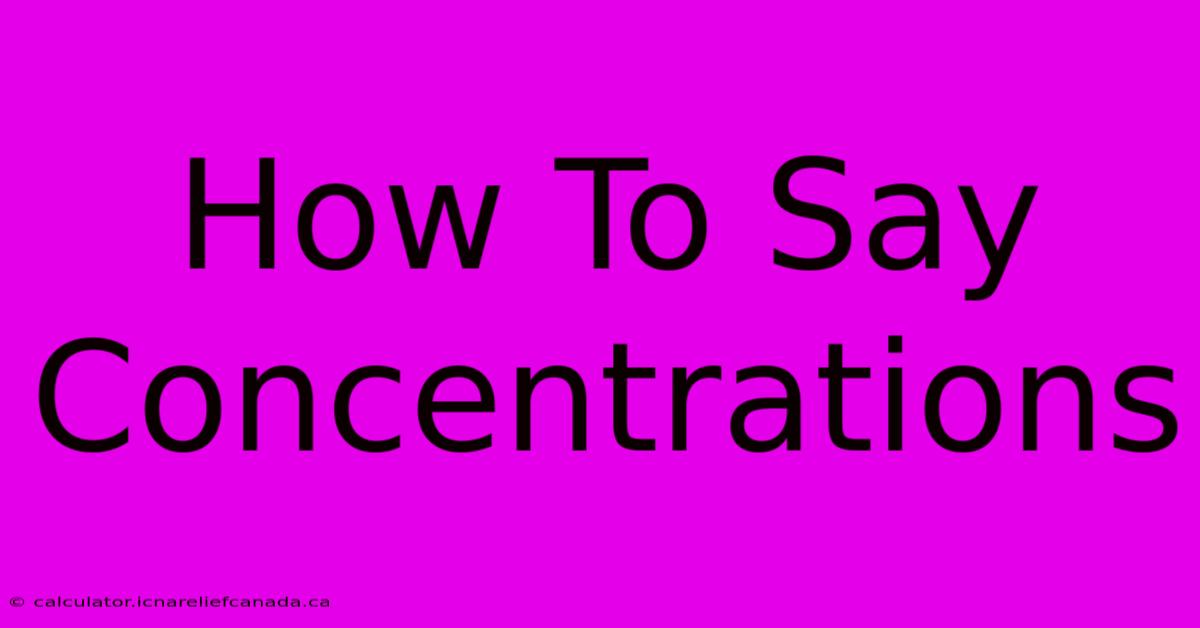How To Say Concentrations

Table of Contents
How To Say Concentrations: A Guide to Expressing Amounts and Proportions
Knowing how to accurately and effectively communicate concentrations is crucial in many fields, from science and medicine to cooking and finance. This guide will explore various ways to express concentrations, focusing on clarity and precision. We'll cover the most common methods, providing examples and explaining when each is most appropriate.
Understanding Concentration: What Does it Mean?
Before diving into the how, let's clarify the what. Concentration refers to the amount of a substance present in a mixture or solution, relative to the amount of the mixture or solution as a whole. It's a measure of how much solute (the substance being dissolved) is dissolved in a given amount of solvent (the substance doing the dissolving) or solution (the solute plus solvent).
Common Ways to Express Concentration
Several methods exist for expressing concentration, each with its own strengths and weaknesses depending on the context.
1. Percentage Concentration (%):
Percentage concentration is perhaps the most familiar method. It expresses the amount of solute as a percentage of the total solution's weight or volume. There are three main types:
-
Weight/Weight Percentage (% w/w): This represents the mass of solute (in grams) per 100 grams of solution. For example, a 10% w/w salt solution contains 10 grams of salt per 100 grams of solution.
-
Volume/Volume Percentage (% v/v): This represents the volume of solute (in milliliters) per 100 milliliters of solution. For example, a 5% v/v alcohol solution contains 5 milliliters of alcohol per 100 milliliters of solution.
-
Weight/Volume Percentage (% w/v): This represents the mass of solute (in grams) per 100 milliliters of solution. For example, a 2% w/v glucose solution contains 2 grams of glucose per 100 milliliters of solution.
Example: A recipe calling for a 5% v/v vinegar solution means 5ml of vinegar for every 100ml of the final mixture.
2. Parts Per Million (ppm) and Parts Per Billion (ppb):
Used for extremely low concentrations, ppm and ppb are particularly useful in environmental science and toxicology.
-
ppm: Represents the number of parts of solute per one million parts of solution. Often used for expressing pollutant levels in water or air.
-
ppb: Represents the number of parts of solute per one billion parts of solution. Used for even smaller concentrations.
Example: A water sample with 10 ppm of lead contains 10 milligrams of lead per liter of water.
3. Molarity (M):
Molarity is a widely used method in chemistry. It expresses the concentration as the number of moles of solute per liter of solution. A mole is a unit representing a specific number of molecules (Avogadro's number, approximately 6.022 x 10<sup>23</sup>).
Example: A 1 M solution of sodium chloride contains one mole of sodium chloride per liter of solution.
4. Molality (m):
Molality is similar to molarity, but instead of using liters of solution, it uses kilograms of solvent. This is advantageous because the mass of solvent is not temperature-dependent, unlike volume.
Example: A 0.5 m solution of sucrose contains 0.5 moles of sucrose per kilogram of solvent.
5. Normality (N):
Normality expresses concentration as the number of gram equivalents of solute per liter of solution. It's often used in acid-base chemistry and titrations. Its use is less prevalent than molarity in modern chemistry.
Choosing the Right Method
The best method for expressing concentration depends entirely on the context:
- Percentage concentration (%): Suitable for general use, recipes, and everyday situations.
- ppm and ppb: Ideal for extremely low concentrations.
- Molarity (M): Essential for chemical calculations and reactions.
- Molality (m): Preferred when temperature changes are a concern.
- Normality (N): Primarily used in specific chemical contexts.
By understanding these different methods and their applications, you can effectively communicate concentrations accurately and clearly in any field. Remember to always specify the units you are using (w/w, v/v, w/v, M, m, ppm, ppb) to avoid confusion.

Thank you for visiting our website wich cover about How To Say Concentrations. We hope the information provided has been useful to you. Feel free to contact us if you have any questions or need further assistance. See you next time and dont miss to bookmark.
Featured Posts
-
How To Pronounce Banh Mi
Feb 08, 2025
-
Liveticker Bayern Siegt 3 0 Gegen Bremen
Feb 08, 2025
-
How To Unlock Inspect Tool 2024
Feb 08, 2025
-
How To Open Bank Bualt Rd2
Feb 08, 2025
-
21 Spieltag Bayern Muenchen 3 0 Werder Bremen
Feb 08, 2025
